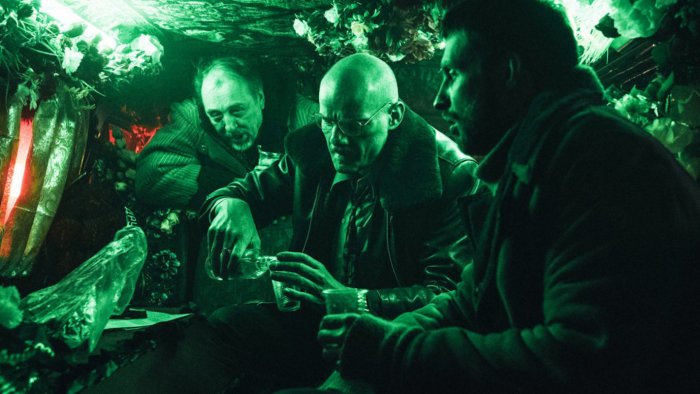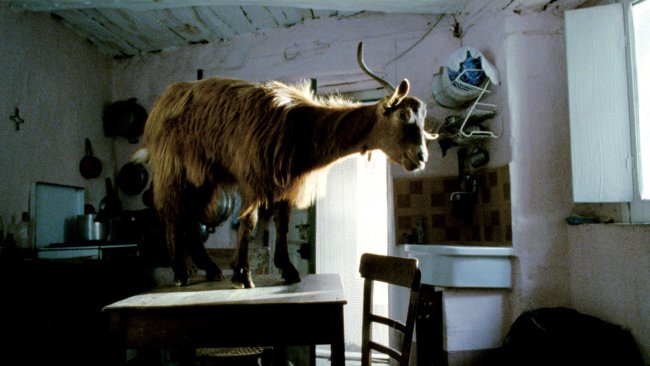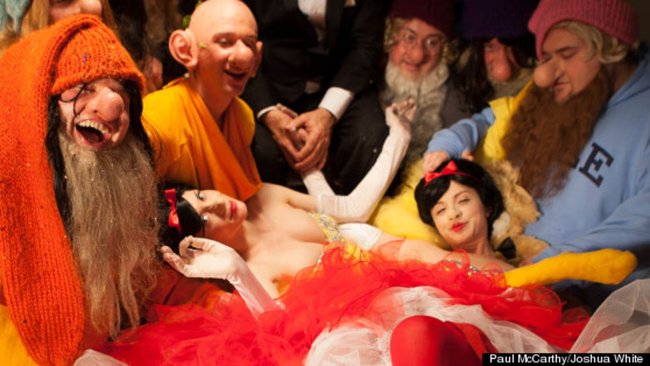Petrov's Flu
[…] Serebrennikov’s craft is superb throughout. The plastic, overflowing there-ness of the mise-en-scène occupies the frame without ever engulfing it as it would, say, in a German film. DOP Vladislav Opelyants injects the overblown sequence-shots that orchestrate the film with something akin to punk finesse.
[…] Having established contemporary Russia as a sort of hell, the film becomes slightly too content to just sit back and enjoy the spectacle.
Text: PM Cicchetti

It is not often that the first twenty minutes of a film set me off in the direction of James Joyce’s Ulysses as I search for suitable comparisons, but the opening act of Kirill Serebrennikov’s latest offering is one such time. The film opens with a galvanic sequence-shot set inside a crammed trolley bus somewhere in Yekaterinburg, teeming with variously dishevelled, variously rambling post-Soviet humanity. The palette reminds me of a Neue Sachlichkeit painting smothered with ashes. Our as yet unnamed protagonist, who has the look of a down-on-his-luck version of Vittorio Giardino’s Max Fridman, sways across the frame as hacking fits of coughing reveal him as the titular flu-affected Petrov. Then, with neither warning nor cut, the film breaks into a hallucinatory fantasy: our Petrov alights from the bus, is handed a rifle, and swiftly takes part in a summary execution of what appears to be a sizeable sample of the Russian government. No wonder Serebrennikov has trouble staying on the good side of the authorities.
From here, a labyrinthine plot begins to unfurl as Petrov is pulled off the bus (this time for real) by a friend pretending to be an FSB officer and taken into a commandeered hearse, as the two of them, plus the recalcitrant driver and the seemingly dead occupant of the hearse, set off to visit a third friend, a mad philosopher who lives in a shack, pontificates about dead gods, and hoards aspirin from the 1970s. By this point I was thinking of Martin Scorsese’s After Hours though it quickly became evident that no sunrise would return Petrov to a semblance of daytime normality. The collapse of the social order here is no parenthesis, no one-night bender. As poets quibble about the length of their work and Petrov’s ex-wife struggles to contain her supernatural murderous urges, the film enwraps the viewer in a fleet-footed carousel of decadence, in the meaning of both (social) decay and (stylistic) self-indulgence.
Is it a sumptuous black farce then, in the region of Céline’s Journey to the End of the Night? In its best moments, yes, and that’s saying a great deal. The opening sequence recasts Bertolt Brecht’s celebrated train scene from Kuhle Wampe, in which wealthy and poor characters discuss the global financial crisis, into a xenophobic scenario of social fragmentation. The revolution has come and gone, and no Solidaritätslied will rescue these souls from their petty misery.
Serebrennikov’s craft is superb throughout. The plastic, overflowing there-ness of the mise-en-scène occupies the frame without ever engulfing it as it would, say, in a German film. DOP Vladislav Opelyants injects the overblown sequence-shots that orchestrate the film with something akin to punk finesse. Objects, people and situations are unmistakeably theatrical, sometimes abrasive, yet the camera eye remains on a strangely delicate wavelength, mixing a degree of gentleness into the swerving pans, the towering top shots, and even into the outbursts of extemporaneous violence.
However, unlike the modernist texts I evoked, the form here never seems to be grasping for more than itself. Having established contemporary Russia as a sort of hell, the film becomes slightly too content to just sit back and enjoy the spectacle. As Mark Asch notes on LWL [https://lwlies.com/festivals/petrovs-flu-cannes-film-festival-review/], the film threads rhyming motifs throughout the plot while also expanding the syuzhet [organisation of the story] with multiple timelines (each delivered in a different gauge and film stock). It’s not just that the formal razzle-dazzle ends up diminishing the impact of the opening blast (though that it does). What gets lost is also the initial modernist impetus, the attempt to meet the chaos of reality with the chaos of form.
Instead gradually, but progressively more clearly, the film turns the modernist page and enters a postmodern chapter. Animated dentures, cosmonaut iconography, alien abductions, right down to the literal resurrection and escape of the afore-mentioned dead man; symbols and metaphors slowly turn into colourful, irreverent signifiers, into an allegorical tapestry whose only allegorical point is really the impossibility of meaning and the futility of memory.
Now this is, at least in principle, all quite punk. To see the Snow Maiden actress (about whom Petrov has been reminiscing for half of the film) conclude her own storyline by throwing up in the lavatory of a school and muttering to the mirror «screw this, I am getting an abortion», while outside the children intone «Thanks to the Party for our new schools» is as cynical a punchline as any, and let it not be said that I do not appreciate cynical punchlines.
Nevertheless, for all its anarchic verve, the film does not wear its postmodern clothes comfortably. To my eyes, something in Serebrennikov’ stylistic bravura feels off: a whiff of contrivance, perhaps even academicism. For all its tonal mastery and extravaganza, the final effect is a touch too tidy, the after-effect hollow rather than haunting, but then maybe that’s the price to pay, in 2021 in order to bring back the dead from their graves.
This article contains a third-party video. If you would like to watch the video, please adjust your settings.
Watch
ONLINE STREAMING (Switzerland) by Filmexplorer's Choice by filmingo.ch and cinefile.ch
Info
Petrov’s Flu | Film | Kirill Serebrennikov | RUS-CH-FR-DE 2021 | 128’ | Geneva International Film Festival 2021
First published: December 01, 2021



